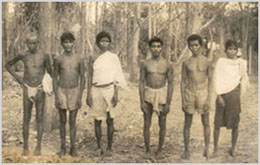Art and Culture of Gajapati District

Tribals form majority of the population of Gajapati District. The Saora Community constitutes the largest group among them and Lanjia Saora is considered most primitive in this district. The Saouras are one of the oldest known tribes of India. They are called by various terms such as Savaras, Sabaras, Saura, Sora etc. But here the term Saora is used uniformly as it is closely approximatestheir language. They are widely distributed from Bundelkhand in the west to Odisha in the east. But they are found in great compactness on the edges of the Eastern ghats in Ganjam, Gajapati and Koraput District of Odisha and Srikakulam district of Andhra Pradesh. The Saoras show their racial affinity to the Proto Australoid physical characters which are dominant among the aborigines of Central and Southern India. Their language is akin to the Kolarian stock which has close resemblance to the forms of speech of the wild tribes of Malayan Peninsula and Nicobar Islands. Their linguistic affinity with the tribes of South-East suggests their migration from the Islands of India Archipelago and Malayan peninsula, unless contrary is proved that India was the cradle-land of the Kolan speaking tribes and the South-Eastern countries were colonized by them. The term Saora appears to have two connotations – one derived from Sagoriss, the Scythian word for axe and the other from Saba roye’, the Sanskrit term for carrying a dead boy. Both of them fit well with their habit of carrying an axe always on their shoulders with their primitive occupation of hunting. The epics and purans refer to their devotion to the Hindu religious heroes like Rama and the Jagannath cult. The legend of Viswabasu, a Saora king who worshipped the image of Vishnu in the term of Lord Jagannath indicates the impact of Vaishnavism on the Saoras. It is well known that, like other tribal communities, the Saoras are the indigenous, autochthons of India in the sense that they had been long settled in different parts of the country particularly on the plains and river valleys and other fertile areas. Many of the Saoras were in a food gathering economy and a few were perhaps on the threshold of a real food producing economy. On the whole, they were in all respects primitive, wild and under developed.

Economic Organisation: The Saoras can be divided broadly into 2 economic classes – (1) The Saoras of the plains depending on their wet cultivation or wage earning and selling fire wood and (2) The Hill Saoras practicing shifting and terraced cultivation on the hill slopes. In most cases the Saoras of the plains are subservient to the advanced section of the neighbouring non-tribal communities.
They provide labour to the non-tribal land owners at the time of weeding, transplanting, harvesting and other agricultural operations and sell firewood and leaf plates in the local markets. In all these works women rather than men take active part and earn the major part of the family income. Village: Saora village broadly confirm to a linear pattern. Each village consists of two rows of houses facing each other and separated by a long and narrow village street. The individual houses in each row are built adjacent to one another thus forming the front veranda of the entire houses- continuous one from one end of the row to the other.
Among the hill Saoras, the villages are situated In the most in-accessible areas that can be imagined and in most cases lie hidden in thick forests making it most difficult to reach them except through zigzag foot paths. Their settlements are not shifting. There is nothing of nomadic nature in their settlement pattern. The size of the Saora village is mainly Governed by the extent of hill slopes and forest land available for shifting cultivation. Hunting: Archery continuous to be important for hunting, fishing and self-protection. The bow-string, like in bow of string instruments is made from tenders of salapa vine. Most of fishing of Saora is still done with bow and arrow. This in turn depending on keen eyesight and sharp reflexes.







